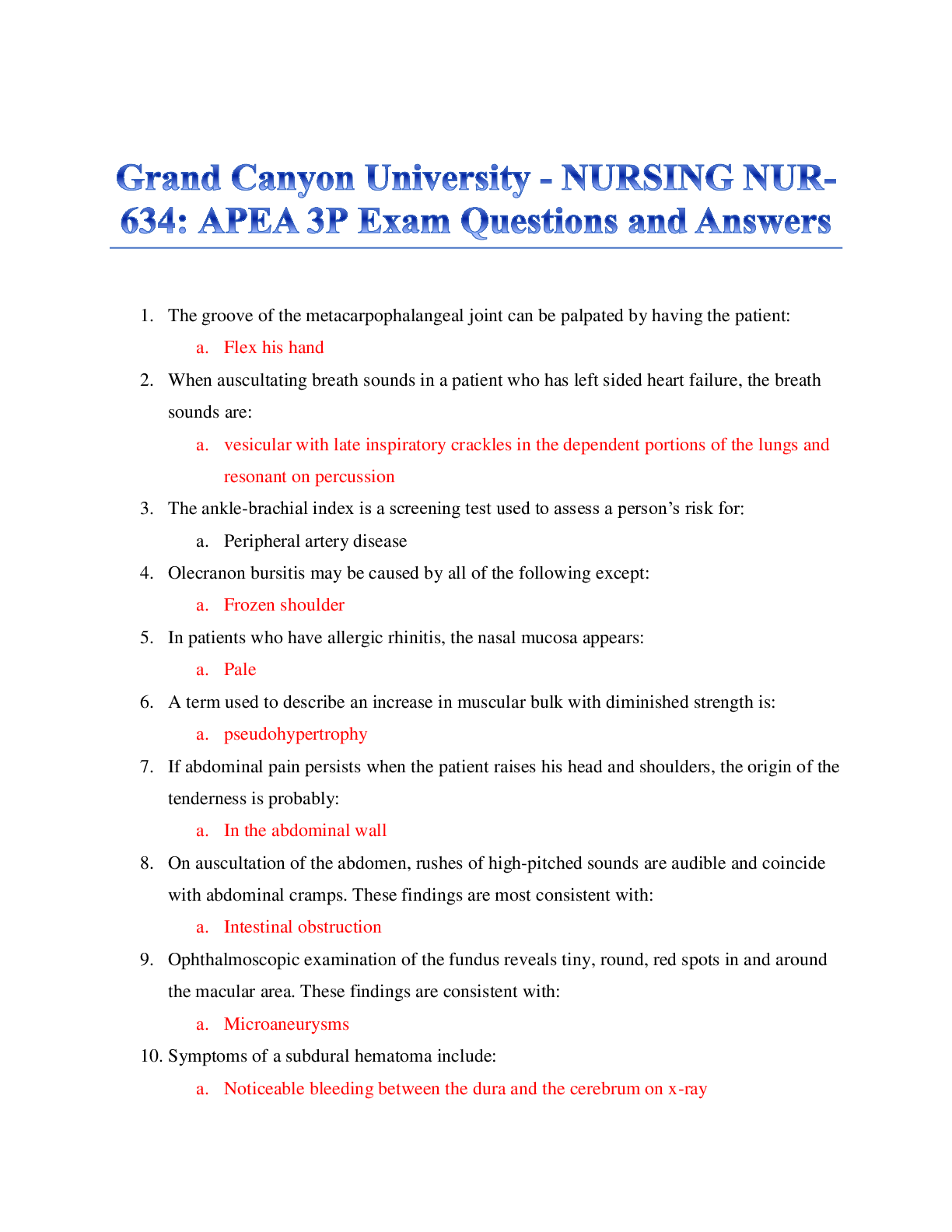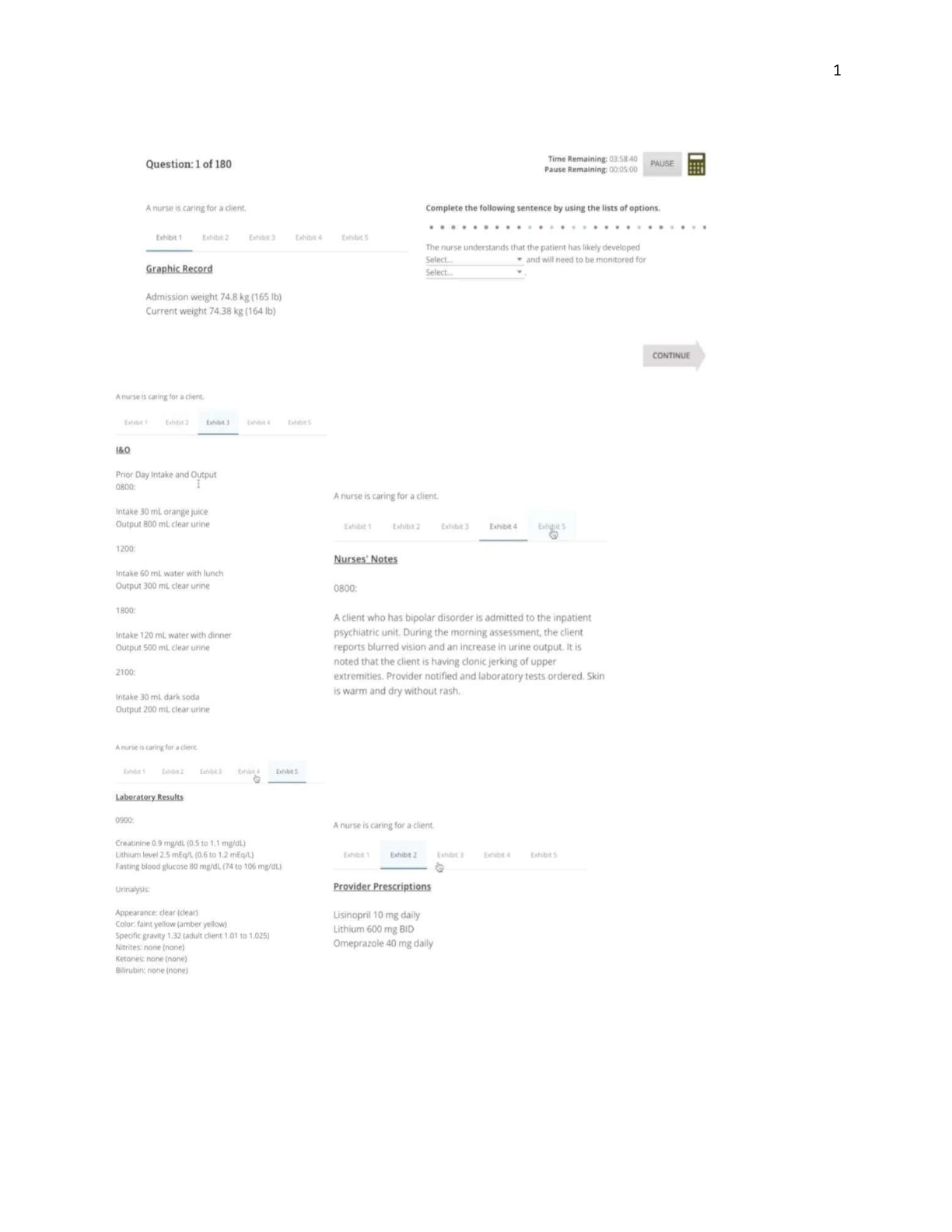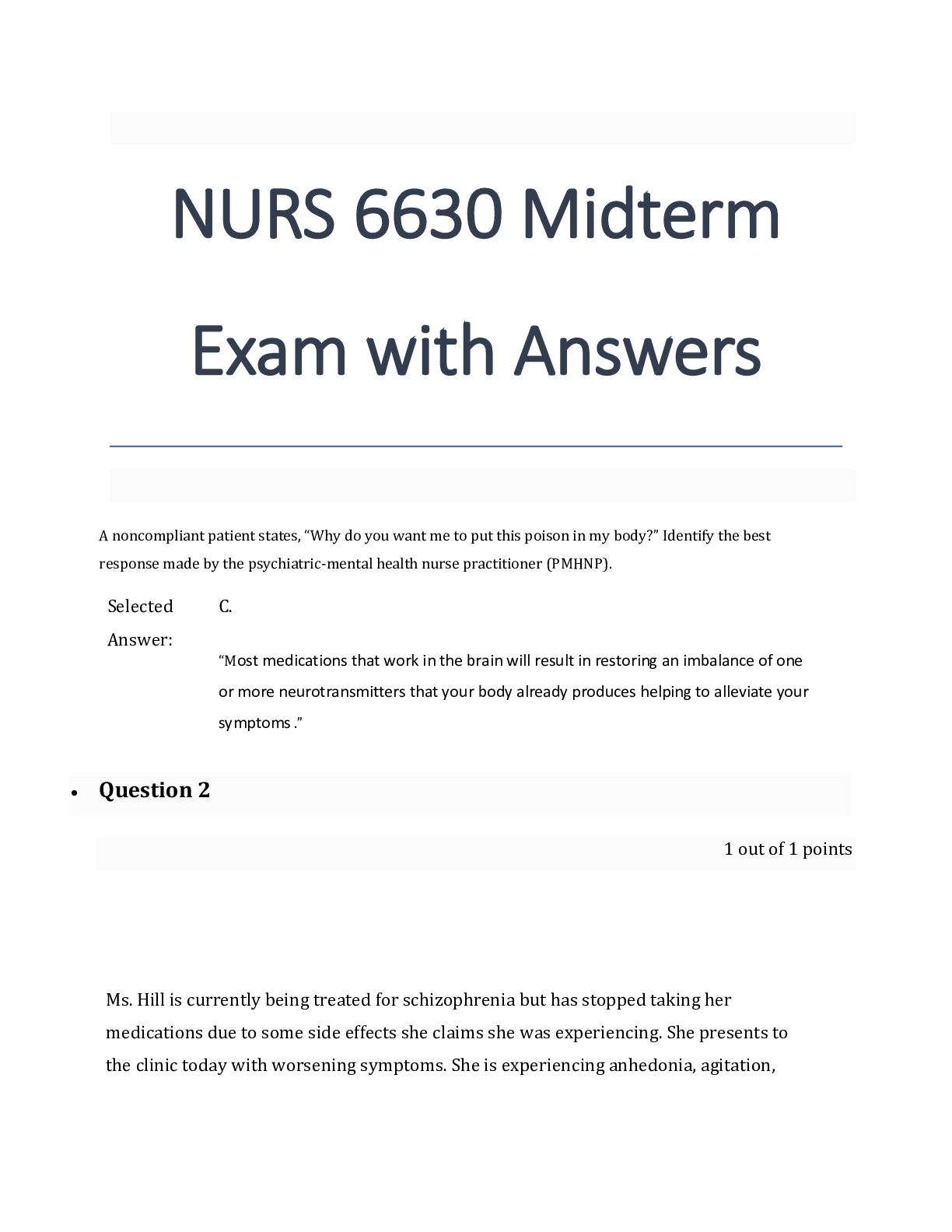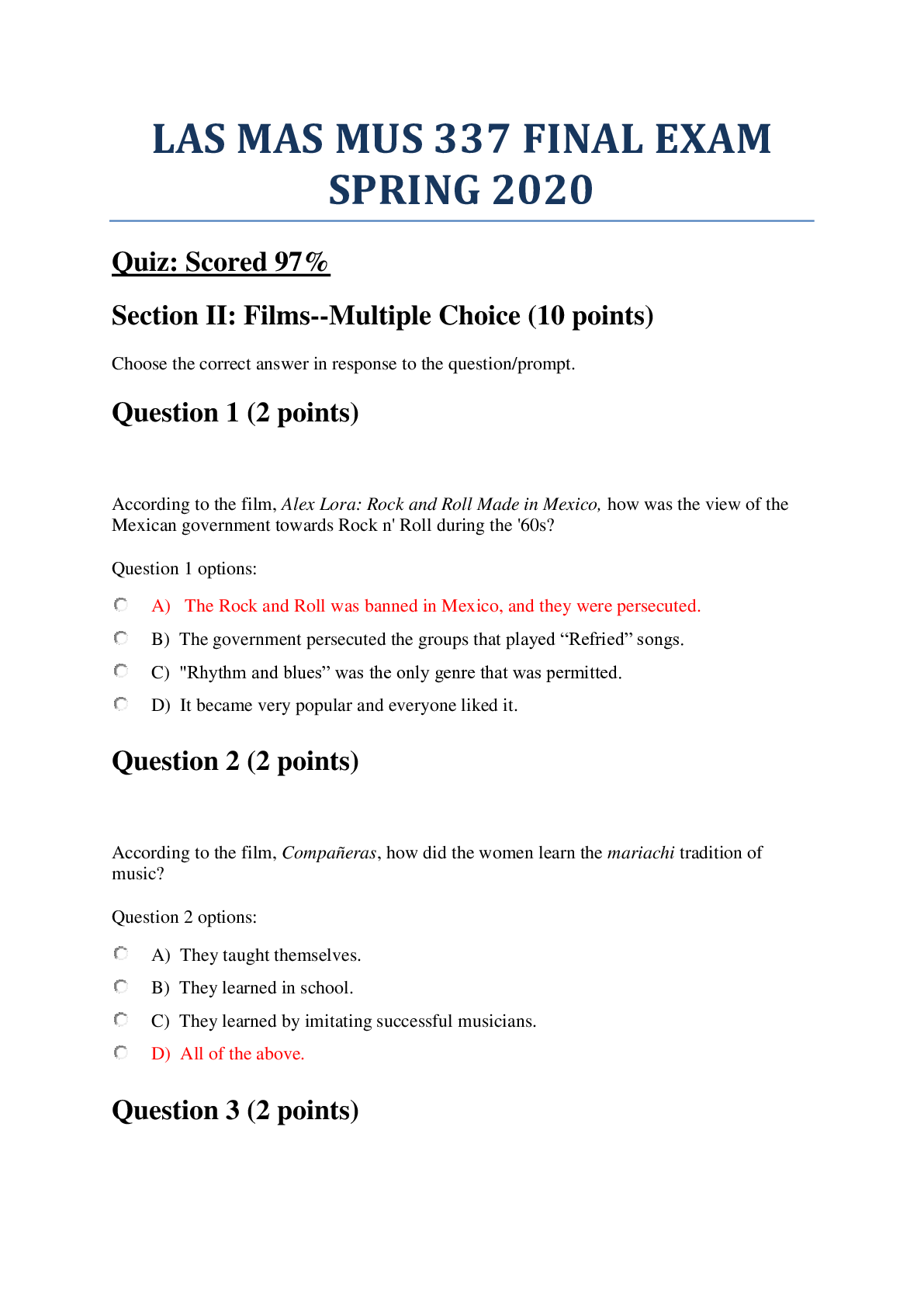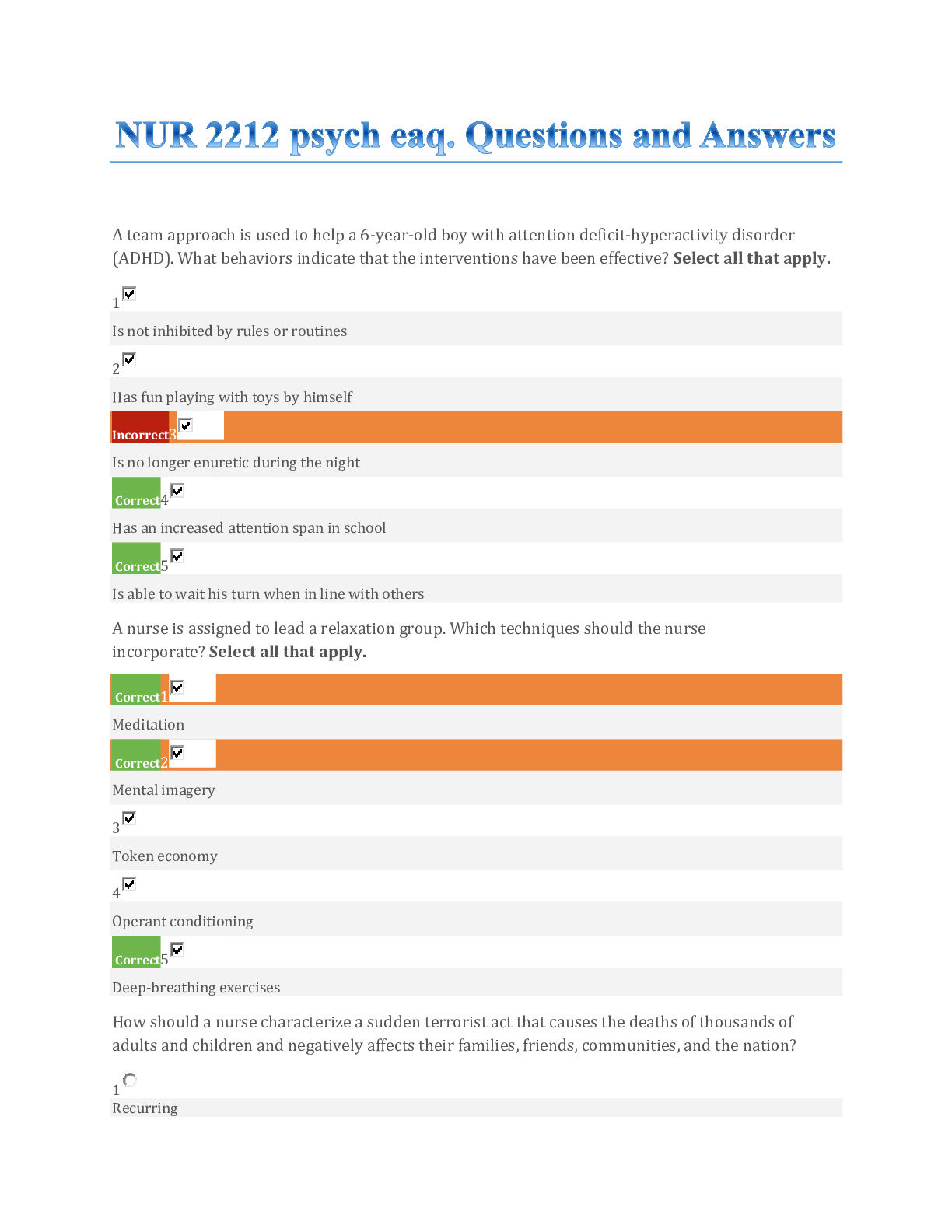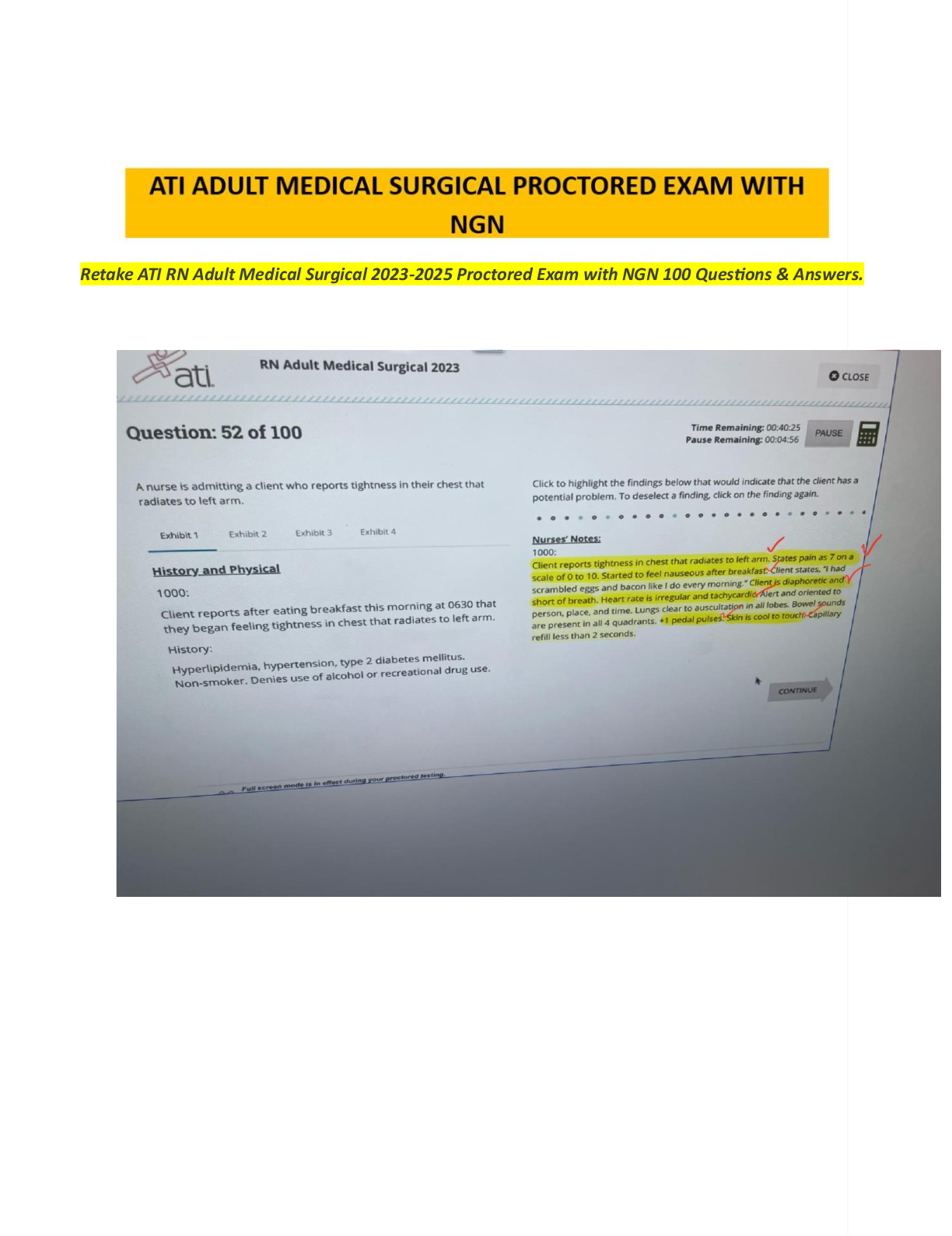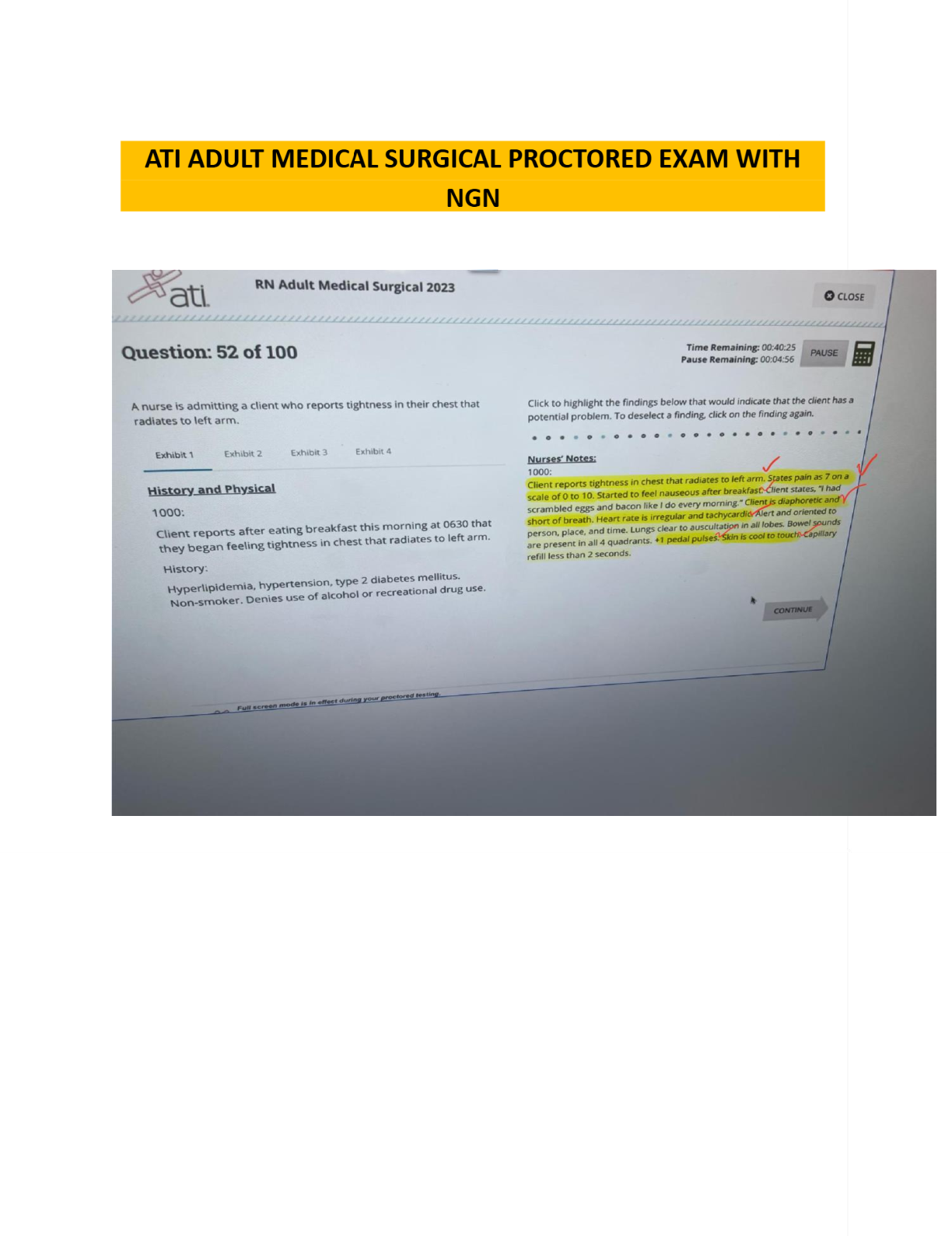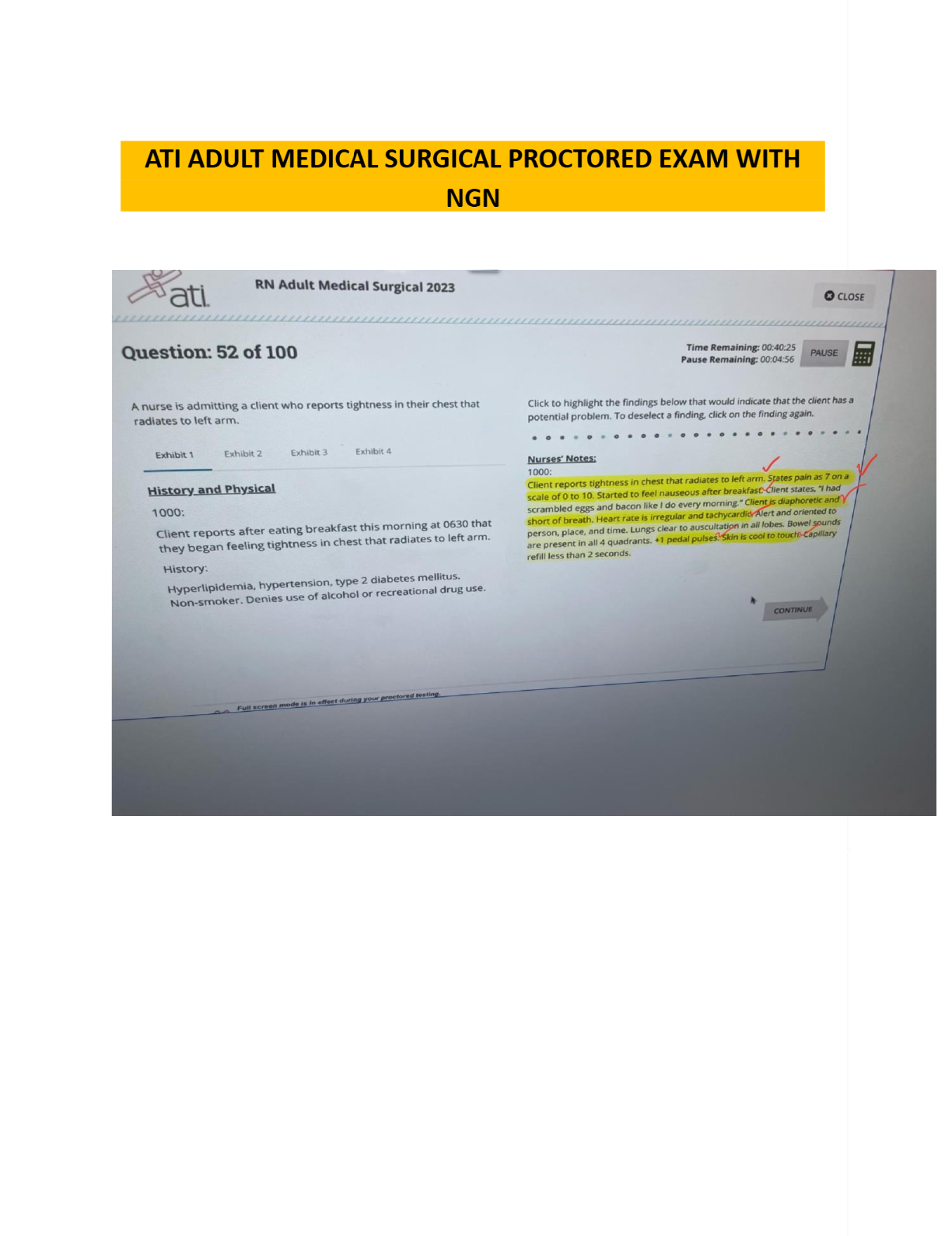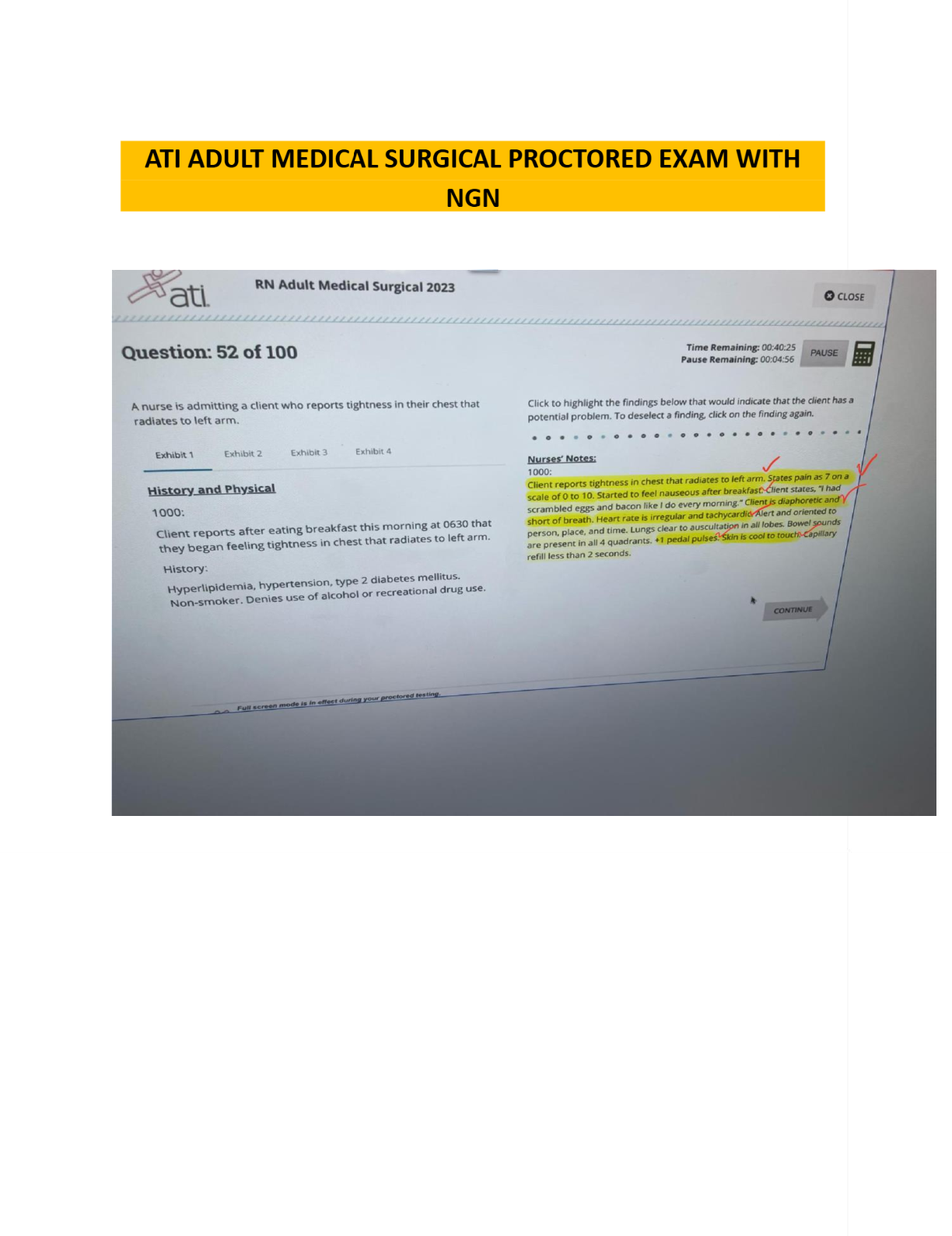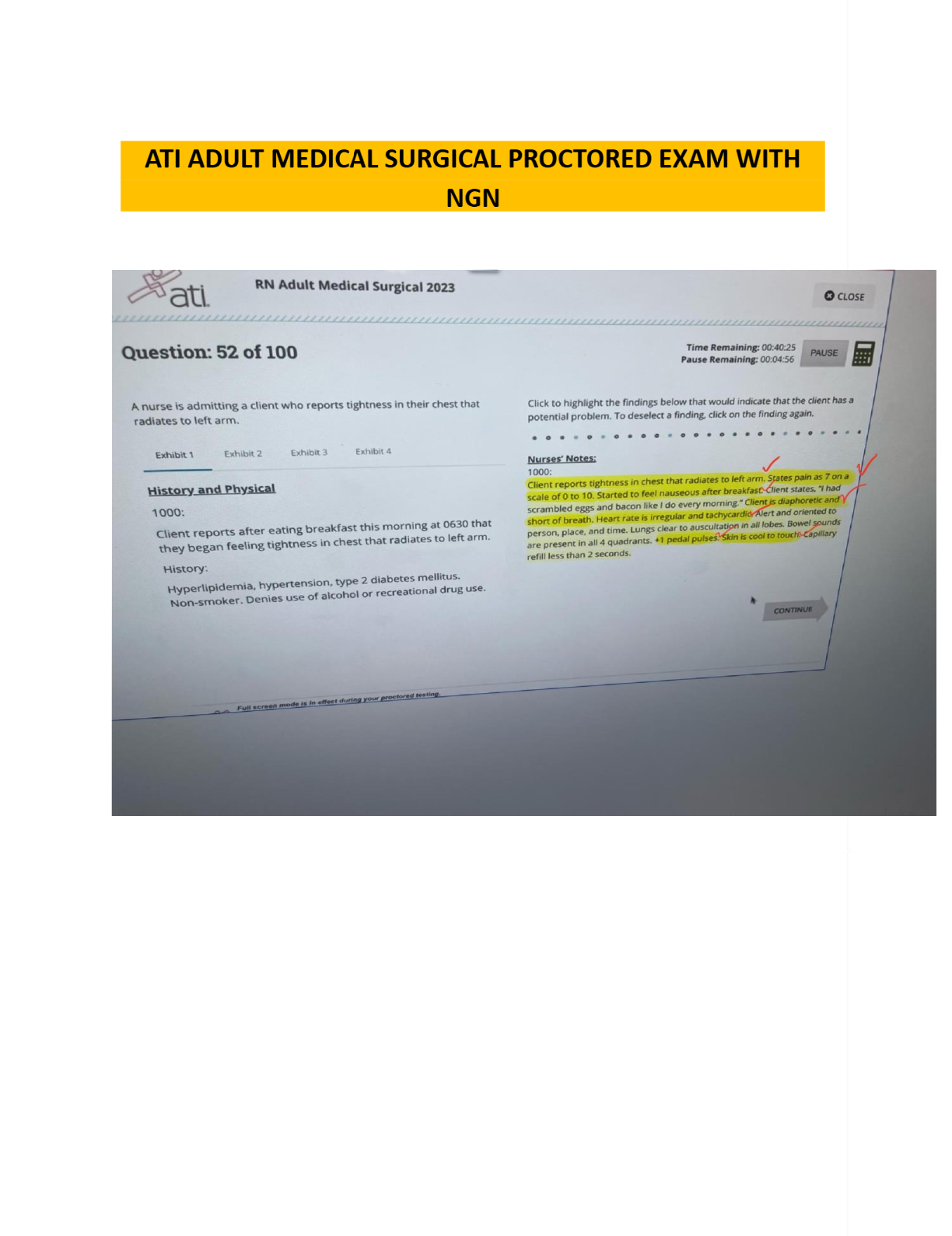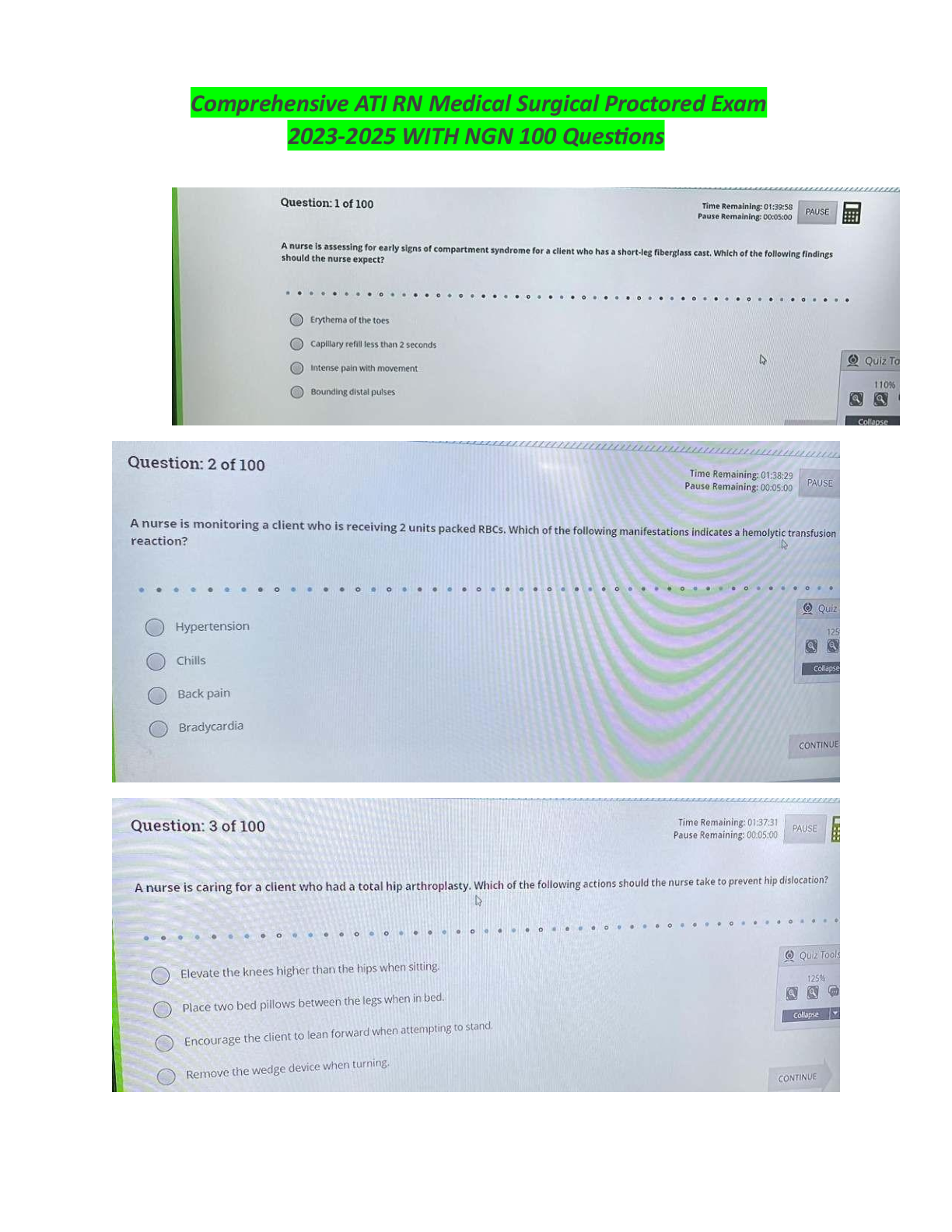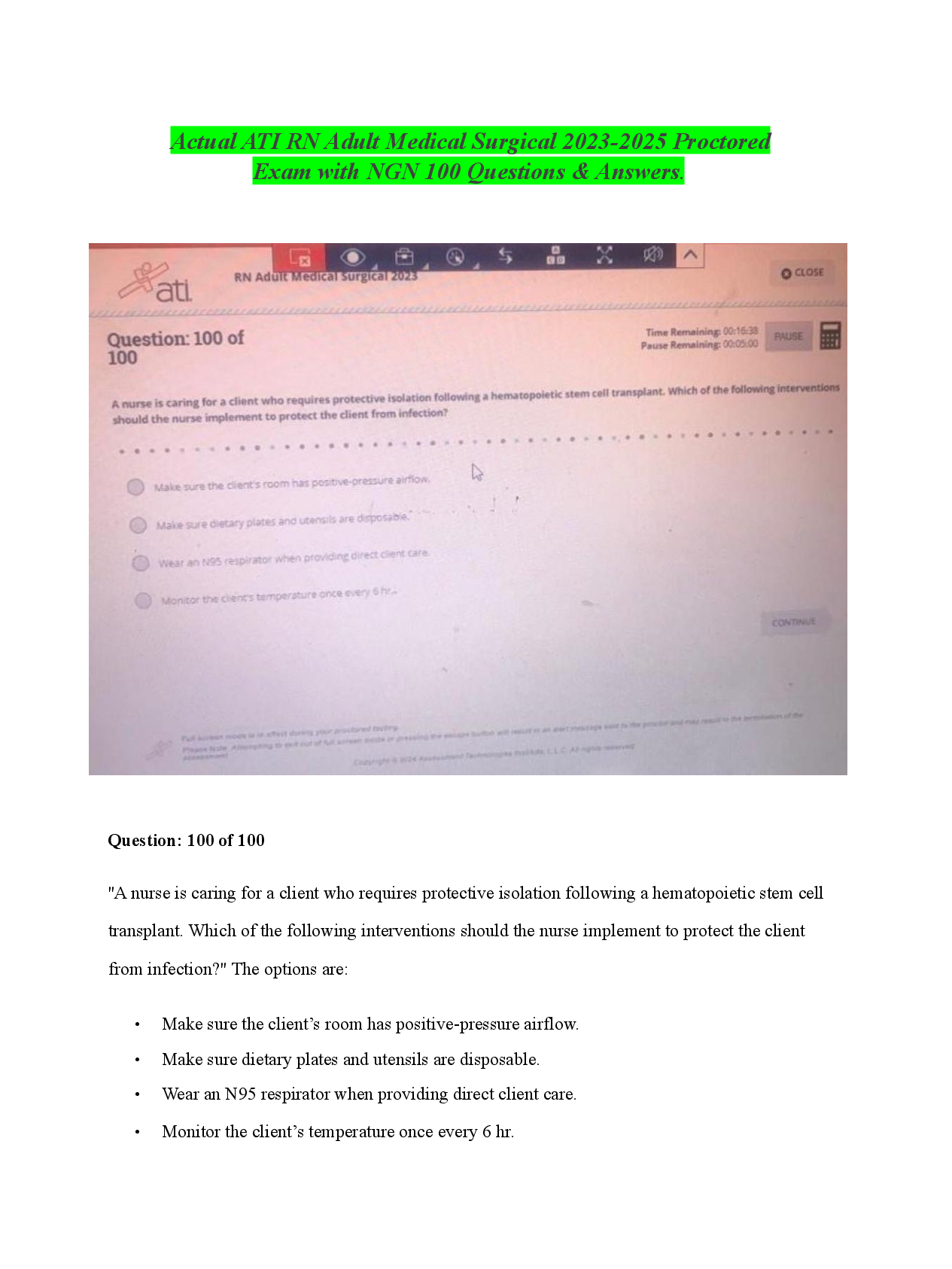Questions and Answers > Arizona State University AST 113 ASTRONOMY Lab 7
Document Content and Description Below
Arizona State University AST 113 ASTRONOMY Lab 7 Lab 7 QUESTION 1 1. Section I. Lunar Features In this section, you will identify specific types of lunar features in several images. The lunar fe ... atures are usually divided into three categories: maria, craters, and highlands: Maria These are the dark areas on the Moon that look like "seas". In Latin the word mare (singular) means sea. Maria are lowland, flat plains that resulted from the flow of lava from the Moon's interior when one or more large impactors struck the Moon and broke through the crust. Many maria are named after psychic states of mind (serenity, cleverness, tranquility). Craters Virtually all of the Moon's craters were formed by meteoroid impacts about 4 billion years ago, in a heavy bombardment period. They are usually circular in shape and can vary in size. On the Moon, the craters are usually named for famous astronomers, scientists, or explorers. The majority of craters seen through a telescope are concentrated towards the highlands and are very old. A few craters are visible in the maria which makes them younger than the event that formed the maria. Highlands These are the mountain-like structures on the Moon. They are the oldest part of the Moon's surface and were not formed by tectonic activity like the mountains on Earth. The highlands were formed by millions of meteorite craters, one on top of the other, that have pushed the top layer of the Moon's surface upward. These features are named after mountains and mountain ranges on Earth. Figure 1. QUESTION 1 Figure 1 (above) is a photo of Mare Tranquilliatis, landing site of Apollo 11. What is the dominant lunar feature in this area? Maria Craters Highlan ds 2 pointsQUESTION 2 1. Figure 2. What is a possible name for the feature in Figure 2? Alpes Tesla Ingen ii 2 pointsQUESTION 3 1. Figure 3. Figure 3 is a photo of Oceanus Procellarum, landing site of Apollo 12. Taking into account the origin of the word "maria", why was the name "Oceanus" chosen? Oceanus Procellarum is an ocean just like the ones we have on Earth Oceanus Procellarum is a really big maria There is no reason behind the name 2 pointsQUESTION 4 1. Figure 4. Figure 4 is a photo of the Fra Mauro highlands, landing site of Apollo 14. Looking at the image and making use of the law of superposition, what features on this landscape were produced first? The highlands The craters We can't tell from this image 2 pointsQUESTION 5 1. Figure 5. Figure 5 is a photo of the Descartes Highlands, landing site of Apollo 16. As we mentioned at the beginning of the section, scientists' names are usually reserved for craters and not used to label highlands. What is the most likely reason that this convention is not followed in this situation? Hint: Descartes was a philosopher and mathematician who was born in 1596. These highlands were initially thought to be a crater The naming convention was established after they were named They get their name from a crater they surround Section II. From Earth to the Moon... and back In this section, you will answer a couple questions related to the Apollo missions and how they traveled to the Moon and back. You shouldn't need any additional information beyond what is provided in the questions. But break out your calculator -- there is a little bit of math! 2 pointsQUESTION 6 1. The Apollo 11 mission landed on the Moon on July 20, 1969 at 20:18 UTC. Given that the average velocity of the spaceship was 1150 m/s and that the distance to the Moon is around 400,000 km, when did the mission launch? July 15, 1969 July 16, 1969 July 17, 1969 July 18, 1969 5 pointsQUESTION 7 1. The Apollo capsules used parachutes to slow their decent on the return to Earth. The capsules had no wings or wheels. Given these characteristics of the capsules, where could the capsules make the most gentle landing after coming back from the Moon? The Kennedy Space Center (Florida, USA) The Sahara desert (Africa) The Atlantic Ocean Section III. Phases of the Moon In this section you will be asked questions about the phases of the Moon and how the Moon would appear at various locations and times. Click the thumbnail below to open a simulator to help you visualize the different phases of the Moon and its appearance. You can use the simulator to explore several aspects related to how we see the Moon from the Earth, such as: 1) the position of the Moon on the sky on different days and times, 2) the fraction of the Moon that is illuminated, 3) the time elapsed since the previous new moon, and so on. Click here to open the simulator 2 pointsQUESTION 8 1. At some point in history, there was a New Moon on Halloween (October 31st). When was the following Full Moon? November 10th November 12th November 14th November 16th 2 pointsQUESTION 9 1. Which phase of the Moon follows the first quarter Moon? New Moon Waxing crescent Waxing gibbous Third quarter 2 pointsQUESTION 10 1. It is common to see the Moon in the daytime (if you look carefully). Consider the Moon's orbit around the Earth. What phase of the Moon will you NEVER see during the daytime? Waxing Crescent Moon Gibbous Moon Third Quarter Moon Full Moon 2 pointsQUESTION 11 1. If it is 6 pm and the Moon is at its highest point in the sky, what is the current phase of the Moon? Full Moon First quarter New Moon Third quarter 2 pointsQUESTION 12 1. Say you know the date of when the last New Moon occurred and you can currently see the Moon on the sky. Which of the following can you determine (at least approximately)? Your longitude When the next solar eclipse will occur The current date and your local time 2 pointsQUESTION 13 1. You can also use this simulation to figure out the "Earth phase" as seen from the Moon. Imagine you are on the Earth and currently see a Full Moon. You have a friend who lives on the Moon. What Earth phase would your friend see? New Earth First quarter Earth Full Earth Third quarter Earth 2 pointsQUESTION 14 1. Think about the configuration of the Moon, the Earth, and the Sun during the different Moon phases. Now think about the configuration of Venus, the Earth, and the Sun. Are we ever able to see a "Full Venus" from Earth at night? Ye s No 2 pointsQUESTION 15 1. Think about the configuration of the Moon, the Earth, and the Sun during the different Moon phases. Now think about the configuration of Mars, the Earth, and the Sun. Are we ever able to see a "Full Mars" from Earth at night? Yes No Section IV. A Brief Detour... The Length of a Day On Earth While we're thinking about orbits, we're going to take a moment to investigate the Earth's orbit around the Sun and how we define the length of a day. We usually think of a day as the time it takes for Earth to rotate once, and we know that one day is 24 hours long. However, if you measure the time it takes for the Earth to rotate exactly 360 degrees, you’ll find that it is actually about 23 hours and 56 minutes -- not 24 hours! This discrepancy arises because there are two different types of days: sidereal days and solar days. And they are often confused! The Earth's true rotation rate is measured by looking at how long it takes for any given star to go from its highest point in the sky one day to its highest point the following day. This time period is 23h 56m 4.09s and is called a sidereal day. On the other hand, if you measure how long it takes for the Sun to go from its highest point one day to its highest point the follow day, you will measure a solar day. The length of a solar day varies slightly over the course of a year, but it's always within a few seconds of exactly 24 hours. So what is the reason for this difference? As the Earth orbits around the Sun, it moves a little forward in its orbit each day. That means the Earth has to rotate slighlty more than 360 degrees for the Sun to be seen at it highest point again from one day to the next. So if the Earth has to rotate a little more, then it takes a little extra time to see the Sun at its highest point again. Simple, right?! There's a simulator for that! Click on the thumbnail below to open a sidereal and solar time simulator. This simulation includes both a solar time and a sidereal time clock. Both clocks mark exactly the same time at exactly one moment every year: the Autumnal (fall) Equinox. Any other moment, they will show different times. You will use this simulator to answer some of the questions below. Take a momemt to familiarize yourself with it before proceeding. Click here to open the simulator 2 pointsQUESTION 16 1. Launch the solar and sidereal time simulation. The simulator starts on the Vernal Equinox (♈), which is in March. You'll notice that the two clocks differ by 12 hours (one shows midnight and one shows noon). Click the "+1" button to advance the simulation by one SOLAR day. Exactly how many SIDEREAL days have now passed since the Vernal Equinox (♈)? 1.00 0 1.00 3 0.00 3 3 pointsQUESTION 17 1. Continue with the solar and sidereal time simlation. Now go to exactly 25 SOLAR days after the Vernal Equinox (♈). What is the SOLAR time? Noon (12 pm) Midnight (12 am) Some other time 3 pointsQUESTION 18 1. | Continue with the solar and sidereal time simulation. In the previous question, you advanced time to 25 SOLAR days after the Vernal Equinox (♈). What is the SIDEREAL time at this point in the simulation? 2:39 AM 1:39 AM 15:05 (3:05 PM) 3 pointsQUESTION 19 1. Most astronomers study stars and galaxies. Which time (solar or sidereal) are astronomers more likely to use to plan their observations? Sidereal time Solar time 2 pointsQUESTION 20 1. In which month does the summer solstice take place? Ma y Jun e July 2 pointsQUESTION 21 1. In which month does the winter solstice take place? Decem ber January Februar y [Show More]
Last updated: 3 years ago
Preview 1 out of 15 pages

Buy this document to get the full access instantly
Instant Download Access after purchase
Buy NowInstant download
We Accept:

Also available in bundle (1)
Click Below to Access Bundle(s)
.png)
Arizona State University AST 113 ASTRONOMY Lab 1- Lab 14 All Scenarios <Questions and Answers>
Questions and Answers > Arizona State University AST 113 Lab 1. All Scenarios Questions and Answers > Arizona State University AST 113 ASTRONOMY Lab 2 Questions and Answers > Arizona State Unive...
By Kirsch 3 years ago
$49
14
Reviews( 0 )
$9.00
Can't find what you want? Try our AI powered Search
Document information
Connected school, study & course
About the document
Uploaded On
Aug 08, 2022
Number of pages
15
Written in
All
Additional information
This document has been written for:
Uploaded
Aug 08, 2022
Downloads
0
Views
550

